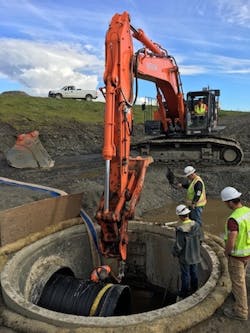Taxiway Touch Up
About the author: Hugh Mickel, P.E., is director of reline technologies for Contech Engineered Solutions. Mickel can be reached at [email protected] or 513.256.7607.
In early March 2016, the Alaska Department of Transportation issued a request for proposals packet that outlined plans for the reconstruction and improvement for Ted Stevens Anchorage International Airport (ANC) Taxiway Y in Anchorage, Alaska. These enhancements included new pavement, an upgrade of the entire taxiway’s edge and centerline lighting systems, and the replacement or rehabilitation of an existing storm drain system.
ANC has been active for more than 50 years and has played an integral role in the growth of Anchorage and the state of Alaska. The strategic location of the airport provides unlimited potential for moving goods, services and infrastructure to be used in the global marketplace, making it among the top five busiest airports in the world. With that in mind, it was important that the improvements to Taxiway Y have as minimal downtime and negative impact to the daily air traffic of the airport as possible.
Planning & Preparation
The Anchorage office of Stantec Consulting Services Inc. was chosen as the engineer of record for the project. One of their challenges was to address the existing 66-in.-diameter corrugated metal pipe storm drain that crosses directly under the taxiway and was in need of rehabilitation or replacement due to its deteriorated condition. They determined that a 54-in.-diameter smooth liner pipe would be sufficient for the hydraulic requirements, and specified a solid-wall HDPE product with 54-in. outside diameter and 50.48-in. inside diameter. This approach would not require the shutdown of the taxiway over the deep storm sewer pipe.
After bids were received and evaluated, a contract for the work was awarded to an Anchorage contractor, Quality Asphalt Paving. Upon receiving the award, the contractor selected a steel reinforced polyethylene pipe (SRPE) manufactured by Contech Engineered Solutions. The pipe would keep the grout from leaking into the pipe during the grouting stages, and is strong, durable and resistant to the effects of temperature and sunlight. It was manufactured with 80-ksi tensile-strength steel-reinforcing ribs. The deteriorating storm drain was under 24 ft of cover height, and the 54-in. diameter pipe weighed 36 lb per ft.
“DuroMaxx is one of many Contech products which can arrive at the construction site with 2-in. grout ports already in place,” said Rian McCaslin, area manager for Contech Engineered Solutions. “These grout ports make for easier grout installation.”
The 20-ft lengths of pipe were manufactured in Ogden, Utah, and shipped to the Port of Seattle, where they were transported by ship to the Port of Anchorage and then, ultimately, trucked to the jobsite in July 2017. Longer lengths typically are used, but the 20-ft lengths allowed for efficient shipping, as multiple shipping modes were used.
To aid in the grouting and bracing process, three 2-in.-diameter grout ports per piece of pipe were installed at the Ogden plant. One grout port each was placed in the 12-, 5- and 7-o’clock positions of each piece of pipe. The grout ports allowed the contractor to monitor the grout level and held the liner pipe in place during grout installation. Skid tubes were installed on each piece of pipe to aid in joint alignment and minimize sliplining friction.
Ted Stevens Anchorage International Airport is one of the busiest airports in the world.
Turbulent Installation
Once submittal documents and shop drawings were approved, the contractor cleaned, dewatered, and inspected the existing host pipe and prepared for the liner pipe to be sliplined directly into the deteriorated storm drain. Preparation work included laying two continuous and parallel timbers along the invert of the host pipe. These timbers would act as rails, which the liner pipe rested on during the pushing process. The rails ensured proper liner pipe alignment and elevation while decreasing the friction between the host pipe and the new pipe.
“The contractor made quick work of installing the liner pipe,” McCaslin said.
The contractor started the pipe insertion on a Friday afternoon and finished the following Saturday. The liner pipe was pushed uphill through a downstream manhole. Grout tubes of different lengths were connected to the liner pipe and pushed into the host pipe along with the liner pipe. The initial grouting plan consisted of constructing bulkheads at each end of the pipe run between the host pipe and the liner pipe. The grout tubes penetrated the bulkheads, which allowed the grouting subcontractor to pump grout into the annulus through the different-length tubes while being able to monitor the grout levels during the grouting process.
The project went smoothly until it began to rain prior to the construction of the bulkheads. Drainage water flowed through the annulus between the host pipe and the liner pipe because the bulkheads were not in place. This water caused the liner pipe to lift, and the various grout tubes caused the floating liner pipe to rotate. Once the water subsided, the contractor learned that the grout tubes and grout ports were out of position and could not easily be placed in the correct position. Contech recommended drilling new 2-in.-diameter grout ports in the desired positions through the pipe wall to allow the contractor to move forward with the construction plan without having to reinstall the pipe, thus staying on schedule. Additionally, it would not jeopardize the quality of the final system.
“Even after the rain threw the contractors team a curve ball, DuroMaxx allowed the contractor to adapt to the situation and overcome to challenge,” McCaslin said.
Once the new grout ports were drilled in the correct positions, the grout subcontractor began to grout between the host and liner pipe through a staged approached with multiple lifts. The grout ports in the 12-o’clock position of each segment of pipe allowed a strut consisting of a steel pipe and bottle jack to penetrate the liner pipe wall and brace against the existing pipe. The bottom of each bottle jack rested on a 4-by-4 beam running along the invert of the liner pipe, spreading the resisting load along the entire length of liner pipe.
The grout used had a fluid unit weight of 50 lb per cu ft. The low unit weight reduced the buoyant forces applied to the liner pipe during the grouting process. The contractor also placed the grout in separate lifts, allowing enough time between lifts to achieve initial set in the grout. After the grout was 8-in. deep at the highest end of the pipe, the contractor filled the remaining void in one lift.
The 54-in.-diameter pipe is manufactured with 80-ksi tensile-strength steel-reinforcing ribs.
Taking Off
Despite Mother Nature causing unexpected challenges on this project, the team’s adaptability created smart answers to overcome them. ANC received a rehabilitated storm drain capable of carrying all the loads and hydraulic capacity required without having to trench through the taxiway. The final system provides a 100-year service life, and the trenchless approach allowed the critical path scheduling to be advantageously shifted. Hugh Mickel, P.E., is director of reline technologies for Contech Engineered Solutions.


